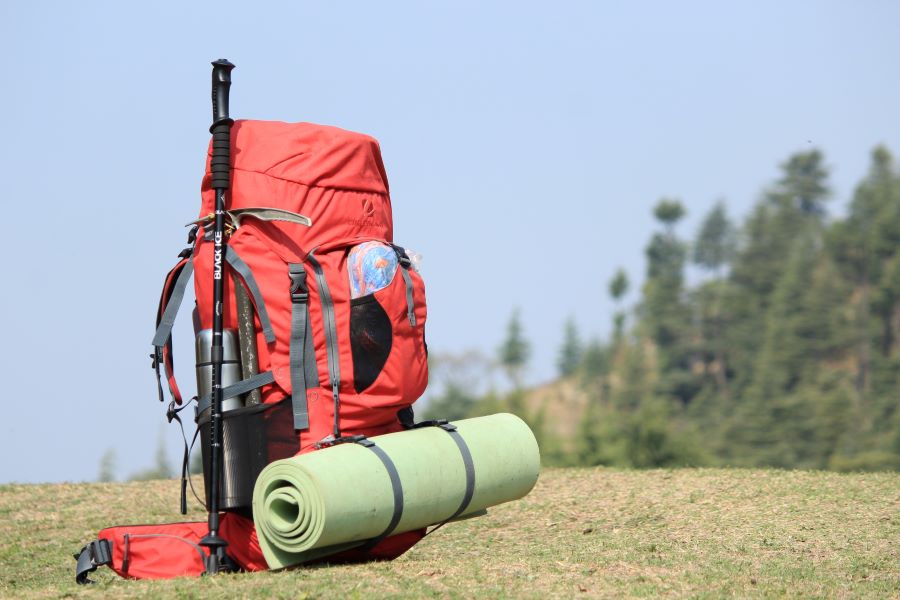Choose Your Own (Outdoor) Adventure: Haz Waste Edition

You’ve studied trail maps and looked up campgrounds in our region for hours. And now you’re ready to get outside.
No matter what your outdoor adventure looks like, the best preparations and gear setups will allow you to enjoy yourself in nature while reducing your exposure to toxic materials. Many products we commonly use during the summer months contain hazardous ingredients or materials, so it helps to be aware of where you can reduce your risk and exposure.
Take a walk with us and choose where your adventure takes you. Every path in this “choose-your-own-adventure” offers guidance around how to pack a bag that’s free of hazardous products and how to safely dispose of certain outdoor gear items once the adventure comes to a close.
The scene is set: You are walking on a dirt path through the woods. It’s summertime, and the sun is shining. Three paths lie before you, leading you to three different outdoor adventures.
Path #1: Camping, hiking, or backpacking
You choose the first path, meandering through the woods and wandering into a tree-lined clearing perfect for pitching a tent. Whether you’re camping, hiking, or on a backpacking trip in the woods, you’ll need to bring the basics – food and water, clothes and extra layers, a sleeping bag or tent (if you’re staying over).
But pay attention to a few items you might take with you:
- Aerosol products (sunscreen, bugspray): If an aerosol can is not empty, it is hazardous waste. You can take full or partially full aerosol containers and cans to one of the Program’s hazardous waste disposal facilities in King County, including Wastemobile events. Only throw aerosol cans in the trash if they are empty.
- Batteries: If you’ve got a headlamp, a lantern, or a lighting device or setup, you’ll likely need to replace their batteries. You can bring dead alkaline, button, cell phone (removable), laptop, lead-acid auto, and rechargeable batteries to a hazardous waste disposal site. It’s always best to individually package or put tape on the ends of lithium or rechargeable batteries to prevent a fire hazard.
- Compressed gas cylinders (including propane and butane tanks): Small gas canisters, such as camping canisters, can go in the garbage if they are empty. Empty or partially filled tanks, 8 gallons or less, can be taken to a household hazardous waste facility.
Path #2: Swimming, boating, or floating
A second path you take leads to a boat ramp and lake. A dip in the lake seems like a cool way to stay chill in the summer heat. You could boat, you could float, or you could just dive in and swim. While you’re out on the water, your general packing list might include a bathing suit, a personal flotation device (PFD), your favorite sunglasses, some water-resistant footwear.
Other items you’ll want to pack in your bag may also need special attention, however. These include:
- Aerosol/spray-on sunscreen: Preventing painful sunburns is important, but knowing what to do once your can is empty is equally as important. You can bring partially full or full aerosol containers, commonly used for spray-on sunscreen, to a hazardous waste disposal site.
- Boat fuel: Staying afloat is often powered by gasoline or fuel. It’s illegal to discharge any petroleum product in the water. But you can bring excess or old fuel to any hazardous waste collection facility, including our traveling Wastemobile events. Waste limits apply, so check the Haz Waste Program product list for more details.
- Marine flares: These emergency devices also contain hazardous materials. If you’re thinking of swapping them out on your boat, bring them to a hazardous waste disposal site instead of throwing them away. Some limits apply, so be sure to know before you go.
For more info on hazardous waste-free water recreation, check out our additional tips.
Path #3: Summer barbecue or picnic
A third and final path trails away, leading into a small shelter in the woods. Your closest friends and family are gathered around a picnic shelter with a grill nearby. That’s right, it’s time for a summer barbecue.
Of course, you’ll want to bring your appetite, a lawn chair or two, and maybe a few of these items that require proper handling:
- Bug spray and insect repellant: Mosquitoes, ticks, and other flying foes are common in warmer months. When possible, select an eco-friendly insect repellent to protect both your skin and the environment from hazardous chemicals. Full or partially full aerosol products or spray cans should be disposed of like any other—at one of King County’s hazardous waste collection sites or Wastemobile events. Pesticides should be taken to a hazardous waste disposal site, as well.
- Ice/cold packs: Every well-stocked cooler has enough ice packs to keep them cool. While it’s best to use reusable ice packs, if you need to dispose of an ice or cold pack, they are accepted at hazardous waste disposal facilities.
- Propane and butane tanks: Empty or partially filled tanks, 8 gallons or less, can be taken to a household hazardous waste facility. If you have a fuel container more than 8 gallons, you can return the tank to the manufacturer or Blue Rhino, a propane exchange company that operates in our region.
- Cooking oils, fats, and grease: These are not hazardous waste, but they do require a special disposal. Put small quantities of fats, oils, and grease into a can. Put the can in the refrigerator to solidify it. Then put the solidified oil into the garbage.
Whichever outdoor adventure you choose, take comfort in knowing you can prepare yourself well, take care of your health, and protect our region’s natural environment.

 Translate
Translate